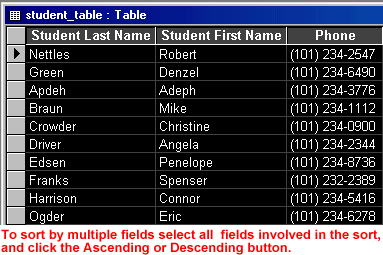Unlocking Data Organization: A Comprehensive Guide to Sorting Records in Access 2000

In the vast landscape of database management, the ability to sort records stands as a fundamental aspect of organizing and analyzing data effectively. Microsoft Access 2000, a powerful relational database management system (RDBMS), equips users with robust tools and features for sorting records with precision and efficiency. In this extensive guide, we embark on a comprehensive exploration of sorting records in Access 2000, unraveling various methods, strategies, and best practices to empower users in their data organization endeavors.
Understanding Record Sorting
Before delving into the intricacies of sorting records in Access 2000, it’s imperative to grasp the fundamental concept of record sorting within the database ecosystem. In Access 2000, a record represents a single instance or entry of data within a table. Each record typically comprises fields representing specific attributes or properties of the data being stored. Sorting records involves arranging them in a specified order based on the values of one or more fields, facilitating easier data analysis and retrieval.
Methods of Sorting Records
Access 2000 offers users multiple methods for sorting records, catering to diverse preferences and workflow requirements:
- Datasheet View Sorting: The datasheet view serves as a primary interface for interacting with table records in Access 2000. Users can sort records within the datasheet view by clicking on the column headers corresponding to the fields they wish to sort by. Access 2000 allows users to sort records in ascending or descending order, facilitating quick and intuitive data organization.
- Query Sorting: Access 2000 enables users to sort records within queries, providing a versatile and powerful approach to data organization. Users can create select queries and specify sorting criteria using the “ORDER BY” clause. By defining the sort order based on one or more fields, users can generate sorted query results that meet their specific data analysis needs.
- Form Sorting: Forms provide users with a structured and customizable interface for viewing and interacting with data in Access 2000. Users can sort records within forms by leveraging sorting features built into form controls or by incorporating sorting logic into form properties or event procedures. Form sorting allows users to customize the display of records to suit their preferences and analysis requirements.
- Report Sorting: Reports offer users a comprehensive view of data in a formatted and printable format, making them invaluable for data analysis and presentation. Access 2000 enables users to sort records within reports by specifying sorting criteria in report properties or by incorporating sorting logic into report controls or event procedures. Report sorting enhances the readability and usability of reports, facilitating effective data communication and analysis.
Best Practices for Sorting Records
While sorting records in Access 2000 is relatively straightforward, adhering to best practices can optimize efficiency, readability, and data analysis:
- Prioritize Key Fields: When sorting records, it’s essential to prioritize key fields that are most relevant to the analysis or retrieval goals. By selecting meaningful fields for sorting, users can ensure that sorted results align with their specific data analysis objectives and enhance the usability of sorted data.
- Consider Secondary Sort Criteria: In cases where primary sort criteria yield duplicate values, users can specify secondary sort criteria to further refine the sort order. Access 2000 allows users to define multiple sort levels within queries, forms, or reports, enabling more granular control over the sorting process and facilitating nuanced data analysis.
- Utilize Indexes: Leveraging indexes on sorted fields can enhance the performance of sorting operations and improve overall query performance. Access 2000 allows users to create indexes on fields used for sorting, facilitating faster data retrieval and analysis. By optimizing index usage, users can streamline the sorting process and enhance the responsiveness of database applications.
- Maintain Consistency: Consistent sorting criteria across queries, forms, and reports ensure uniformity and coherence in data presentation and analysis. Access 2000 provides tools and features for saving and reusing sorting criteria, enabling users to maintain consistency in sorting practices and enhance the usability of sorted data across different database objects.
Conclusion
In conclusion, mastering the art of sorting records in Access 2000 is essential for efficient data organization and analysis. By leveraging the diverse methods, strategies, and best practices outlined in this guide, users can streamline the process of sorting records, enhance data readability and analysis, and unlock the full potential of Access 2000 for effective database management. Whether you’re a novice user or an experienced database administrator, proficiency in sorting records empowers you to navigate the complexities of data organization with confidence and precision.




